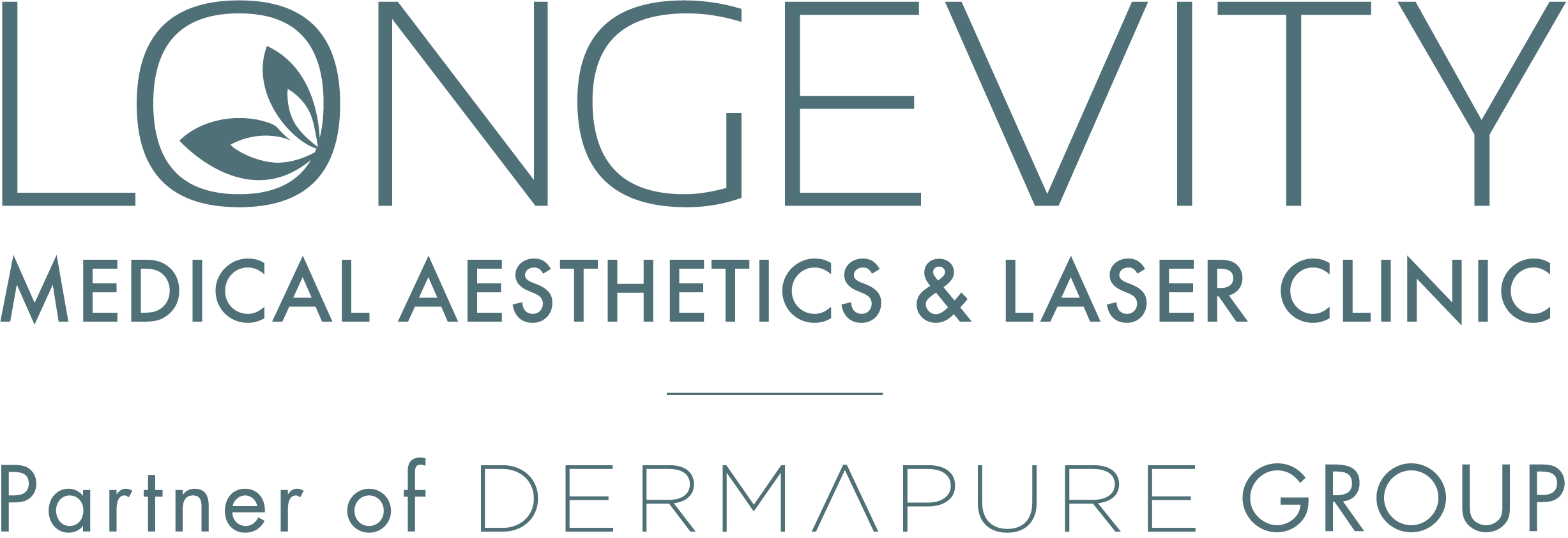Ulthera®
![]()
Ulthera® is the best non-invasive treatment to date for tightening skin with a tightening effect, without surgery. With 88 patents filed and 46 clinical studies to support it, ultherapy treatment has earned an enviable reputation around the world, even among medical professionals specializing in plasty. This is a very popular corrective treatment, which offers results that can be visible within 3 to 4 months of the session.
TREATMENT & TECHNOLOGY
Ulthéra® relies on a technology based on focused ultrasound to tighten skin tissue. This non-invasive technology offers a tightening effect with the most natural results particularly effective for the oval of the face, eyebrows, neck and décolleté.
During treatment, ultrasound is delivered through a tip and concentrated at different subcutaneous depths. Thousands of tiny attachment points are generated in the structure that supports the face, under the epidermis, dermis and hypodermis. A regeneration of the tissues is thus provoked and allows to gradually restore the memory of the skin and the underlying tissues. The top layer of the skin remains intact, and the smoothing effect is gradual and natural. In addition to temporary localized redness, sometimes swelling and transient tenderness on the treated area, no downtime is necessary.
The Ulthera® procedure has proven itself around the world, even with plastic surgeons who recognize its effectiveness. Ulthera® has been recognized several times as the best non-invasive treatment for skin tightening by New Beauty Magazine.
Reaching a subcutaneous depth of 1.5 mm, 3 mm or 4.5 mm, Ulthera® can work at the same depth as that usually targeted during a surgical facelift. The face – whole or depending on the targeted areas, i.e. forehead, eyebrows and mouth circumference; The neck and neckline are thus smoothed and firmed. Ideal for people who want a progressive, visible and natural tightening effect.
To discuss Ulthéra® procedures in more detail, schedule a complimentary consultation @ 250.586.1883
TREATABLE AREAS
![]()
The face, eyes, neck and décolleté are the big favorites for an ultherapy treatment. These regions are most often affected by a loss of tone and respond well to ultrasound. Depending on your needs, it is also possible to address the face either whole or in part. We could very well target only the jaw to better redefine the oval of the face or, only the eyes, to clear the eyelids, smooth fine lines and open the eye. Ulthera® is often combined with volumizing injections for a more pronounced rejuvenating effect. This treats both sagging flesh with ultherapy and deep hollows with hyaluronic acid.
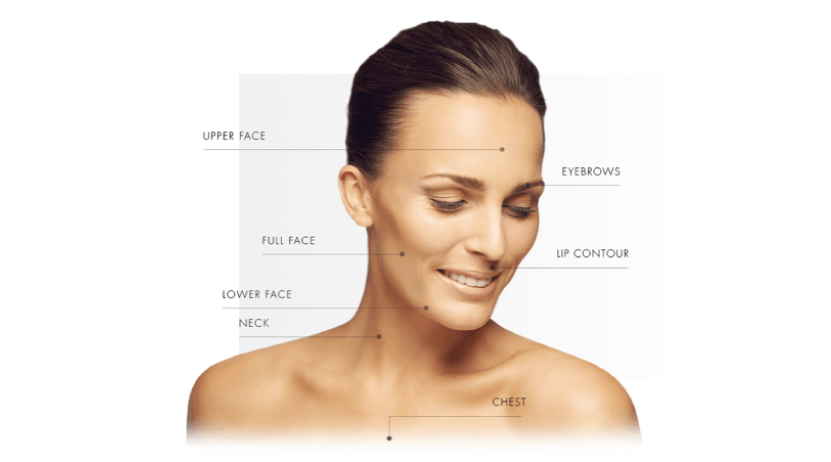
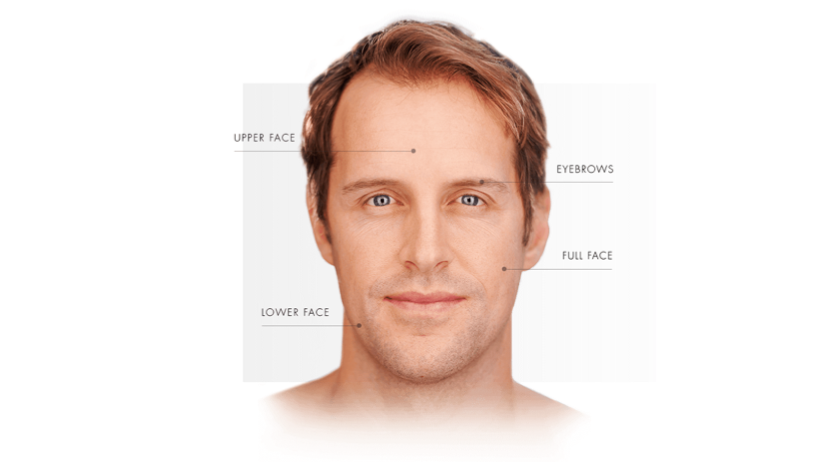
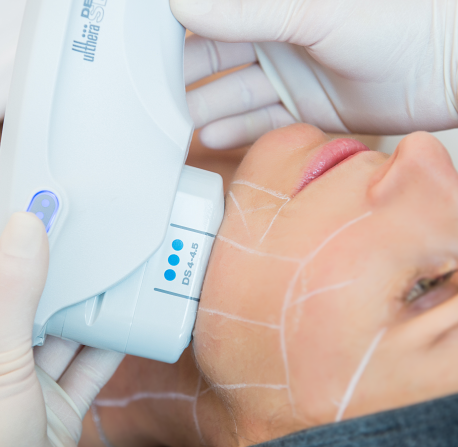
BOOK A COMPLIMENTARY CONSULTATION
![]()
CALL 250.586.1883
CONDUCT OF A SESSION
Personalized assessment
Determining the degree of laxity of your skin is an essential step in treatment like Ulthera®. Not only do you have to validate your corrective needs versus those preventive, but also clearly identify your expectations. The skin, depending on its condition and age, will respond differently to ultrasound; We need to see and touch it to make a final diagnosis. Whether or not ultherapy meets your expectations, we make it our duty to be transparent at all times.
Marking targeted areas with a suitable ruler
Drawing thin lines on previously cleansed skin helps to delimit the areas that will be treated. Using a pencil and an adapted and precise ruler, the technician draws up a temporary canvas of white columns, which will serve as guidelines throughout the treatment.
Applying an ultrasonic gel
Using an ultrasound gel is essential, considering the use of an ultrasound module during treatment performance. A thin layer, maintained throughout the session, will help a good ultrasound reading.
Ultrasound reading
Visualizing fabrics up to 8 mm deep on a screen is what Ulthera®’s patented DeepSEE technology allows. The handpiece, equipped with an ultrasound probe, is affixed to the skin and allows the technician to visualize the subcutaneous layers to ensure an effective and safe treatment. This ultrasound reading will indicate how deep the technician can deliver the ultrasound. For example, it will avoid the middle of the forehead, which is very bony, as well as the facial nerves while the cheeks will be treated up to 4.5 mm deep, very close to the muscle.
Start of ultherapy treatment
Delivering the ultrasound until the treatment is completed can take 30 to 90 minutes, the time to emit all the impulses required to stimulate the production of new collagen. Guided by the guidelines and the visual of the ultrasound, the technician will make sure to adapt the treatment to your physiognomy, sometimes insisting on crow’s feet, the crumpling of the neck or on the “jowl” effect. The intense heat and tightness can be very uncomfortable, depending on the patient, and can be alleviated by taking Tylenol and Advil combination tablets.
Maintenance care
Repeated Ulthera® treatment every two years is highly recommended. In addition to solidifying the subcutaneous attachment points, scientific studies have demonstrated a real thickening of the skin at the sites treated with micro-focused ultrasound, thus reversing the tendency to thinning the epidermis with age. Ulthera® can also be performed alternately with Thermage®: the former will target more corrective needs while the latter will act preventively.
Also, it is imperative to perform 4 sessions per year of Venus Freeze MC / Venus Legacy MC in order to accumulate the effects of radiofrequency throughout the year and continuously stimulate the production of superficial collagen.
Once the desired results are achieved, the effects are long-lasting and can be maintained as part of a healthy lifestyle.
Contraindications
Pregnant or breastfeeding women should postpone this type of treatment at a later date.
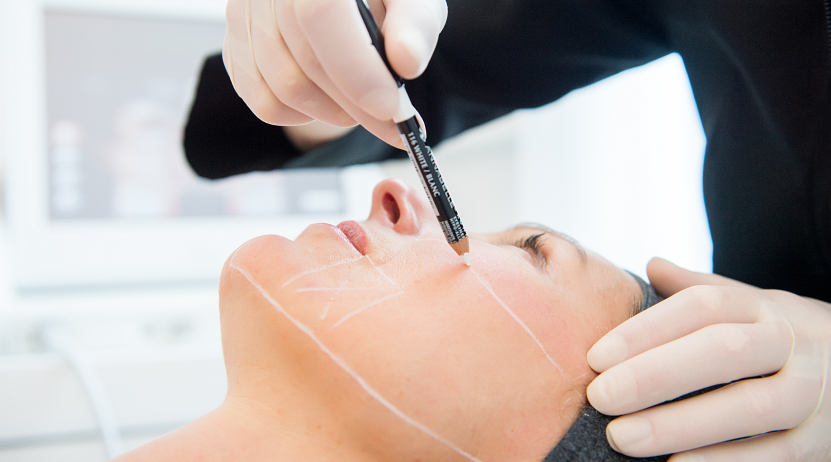
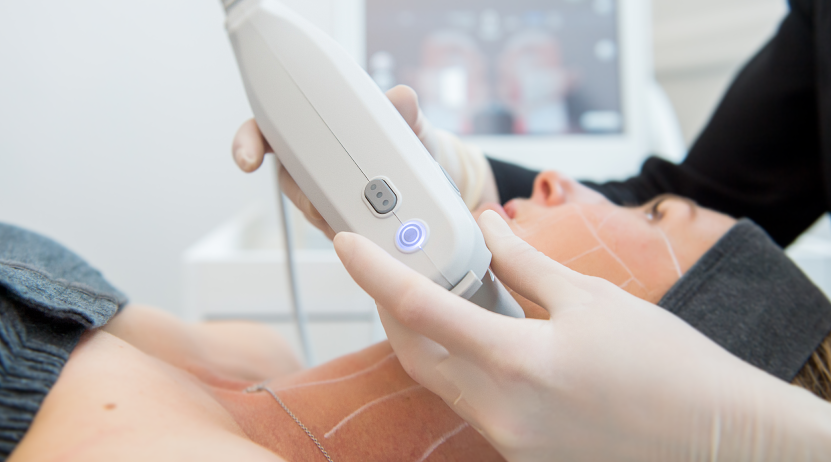
FAQs
Am I a good candidate for the Ultherapy® treatment?
A good candidate for Ultherapy is someone with a mild to moderate degree of skin laxity, to the point of looking, and often feeling less firm. Loose skin under the neck and under the chin, or lines and wrinkles on the chest, are signs a patient might be a candidate. The best way to determine if you are a candidate and the recommended treatment to achieve your goals is to book a complimentary consultation, in person or virtually.
When should I have my first Ulthera® treatment?
For most patients, it is recommended to consider the Ultherapy treatment in your early thirties, when you are starting to experience early signs of aging. As we age, the collagen that keeps our skin firm breaks down. As early as age 25, collagen production slows and results in aging skin, fine lines and wrinkles. Thus, preventative treatments are recommended in order to maintain skin firmness and prevent the signs of aging. This treatment is also recommended for mature skin to obtain a natural lifting effect without surgery or downtime.
How does Ultherapy work?
Ultherapy is a non-invasive treatment that uses ultrasound energy to lift and tighten loose skin over time, without any downtime. Targeting the deep, structural layers of the skin, Ultherapy uses microfocused ultrasound to generate a thermal effect under the skin. The thermal effect essentially jump-starts your body’s own process that produces new collagen.
Does Ultherapy replace surgical procedures?
Ultherapy treats the deep foundational layer of the skin addressed in cosmetic surgery, but it will not duplicate the results of a surgical procedure. Ultherapy is an effective, non-surgical alternative for lifting and tightening the skin with natural results. Ultherapy may be recommended to maintain surgical results longer.
How long does the Ulthera® treatment take?
The Ultherapy appointment can take anywhere from 30 to 90 minutes, depending on the area being treated and the desired results.
What areas can be treated with Ulthera®?
Ultherapy can treat face, brows, neck, décolleté are the most frequently treated areas with Ultherapy. The treatment can be customized based on your needs and the desired result.
How long will the effects of Ultherapy last?
For most patients, results of an Ulthera® treatment appear gradually in the two to six months following a single treatment session and can last for 1-2 years depending on your skin condition and aging process*. It is recommended as part of an annual skin rejuvenation maintenance program.
*Individual results may vary.
How many Ulthera® treatments are needed?
Most patients only need one treatment of Ultherapy to obtain desired results; however, some may benefit from more than one treatment, depending on the degree of skin laxity and the body’s unique biological response to the ultrasound and the collagen-building process. Follow-up Ultherapy treatments are recommended each year to help maintain results.
Your personalized treatment plan, carefully prepared by one of our experts, will guide you toward your skin goals.
Does the Ulthera® treatment hurt?
As the ultrasound energy is delivered, you may feel a short, localized intense hot sensation – tiny amounts of energy being deposited to precise depths, stimulating the collagen-building process. Comfort levels vary from person to person, but the sensation only lasts while the ultrasound energy is being delivered.
Are there any common side effects of Ultherapy?
There may be slight redness that typically resolves within a few hours following the treatment. Some patients may have slight swelling, tingling, or tenderness to the touch, but these are mild and temporary in nature. Superficial skin dehydration can be observed in the following weeks after treatment.
How long before I can get back to my normal activities?
Most patients return to their regular activities immediately following the Ulthera treatment, although it is possible to experience temporary redness or minor swelling of the treated area in the 24 to 48 hours following the treatment.
What is the difference between Thermage® and Ulthera®?
Thermage® uses radiofrequency energy while Ulthera® uses ultrasound energy. Thermage® treats more superficial lines and wrinkles on various parts of the face and body and is recommended as a preventive treatment. On the other hand, the corrective action of Ultherapy targets deeper layers of the skin on the face, neck, brow, and décolleté to lift and tighten the treated area. Both treatments are recommended as part of an annual skin rejuvenation maintenance program and can be combined or alternated for optimal results.
